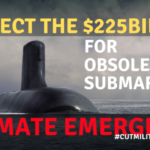Albanese Condemns Australia to Decades of Austerity, as Bipartisan Militarisation Continues

US president Joe Biden cancelled next week’s Sydney Quad Leaders’ Summit on Wednesday.
But not to worry, as China-focused security meetings are now coming so thick and fast that the next one will be around soon enough, especially with the growing prospect of warring on the East Asian giant.
Of course, there’s a touch of lament as the leader of the AUKUS powers will no longer grace us with his presence, which would only be heightened for Anthony Albanese, who’s missed an opportunity to have his photo taken standing beside his commander-in-chief before the Sydney Opera House.
The Quad, a security dialogue between the US, Japan, India and Australia, has become of increasing importance ever since former PM Scott Morrison and his British and US counterparts announced the AUKUS pact in September 2021, which was due to “security challenges in the Indo Pacific region”.
Key to AUKUS is Australia acquiring eight nuclear-powered submarines (SSN), utilising US and UK technologies, that, in conjunction with an enhanced US military presence on local soil, will provide us the ability to attack China, as well as turn the country into a frontline base in an Indo Pacific conflict.
And in keeping with this US-led initiative established under Coalition governance, the Albanese government has been gleefully forging ahead with the project that will increasingly militarise the economy, as well as condemn the Australian public to decades of austerity.
Destabilising the Indo Pacific
“You can’t look at the Quad and AUKUS developments and take a neutral stance,” said Greens Senator David Shoebridge. “We need to see it for what it is, a concerted effort to engage in an arms race to project lethal force against China.”
“That is the strategy that informs the extraordinary almost half a trillion-dollar commitment to public expenditure for submarines for Australia,” he told Sydney Criminal Lawyers.
During the 14 March announcement of the AUKUS submarine agreement details, which did afford Albanese some great shots on a podium beside Biden and his fellow AUKUS co-deputy UK PM Rishi Sunak, it was dropped on the Australian public that the cost of the deal was going to be $368 billion.
But the Australian Greens dug a little deeper, and in consulting the Parliamentary Budget Office (PBO), it confirmed that the eight nuclear-powered submarines are actually going to cost local taxpayers closer to half a trillion dollars.
Shoebridge added that the aggressive approach to China is “also the underlying rationale for the Quad security architecture”.
“This isn’t just a neutral containment strategy,” he added. “It is literally designed to project that lethal force against China and that’s a dangerously destabilising element in our region.”
Welcome to the war economy
The Morrison government committed to a $270 billion military spend on equipment and expansion over a 10 year period, as part of its 2020 Defence Strategic Update. This “record” spend was focused on China, with “more potent capabilities” being acquired, including longer-range strike weapons.
While the Albanese government last month released the Defence Strategic Review 2023 and its response to it, confirming that the country will continue to expand its military capabilities and spending, which will include “much greater… longer-range strike capability”.
“Defence spending will need to grow,” said hawkish defence minister Richard Marles. “It is absolutely our expectation that defence spending over the medium term, over the decade, will grow above the existing trajectory of growth that we inherited from the former government.”
Shoebridge makes clear that what we’ve seen “with the change in government from the Coalition to Labor is that there has been zero change in the trajectory of increased defence spending and increased militarisation in Australia”.
“We have seen the Albanese government deliver the Coalition’s entire military strategy and its alliance strategy – and do it with a smile,” he added.
In terms of the cost of AUKUS, the senator explained that the extra $123 billion that the independent PBO uncovered in addition to the $368 billion AUKUS spend is due to the fact that the original amount cited covers the cost of five nuclear-powered submarines acquired by 2055.
“Under the AUKUS SSN program, Australia will have delivered three second-hand Virginia-class submarines and the first five of eight yet-to-be-designed AUKUS SSN submarines,” Shoebridge explained, “then there’s another three submarines to be delivered in the decade that follows.”
The White House AUKUS Fact Sheet outlines that by 2027 a joint US-UK nuclear-powered submarine force will be established in Australia, to cover us if the war breaks out in the meantime, which will then be followed by our nation buying three US Virginia-class submarines early next decade.
By the early 2040s, Australia will deliver its first locally-built UK-designed AUKUS SSN, and we should have produced five such subs by 2055. However, the plan involves eight, so by the mid-2060s, Adelaide’s Osborne Naval Shipyard should have produced the remaining three AUKUS subs.
“The truth is $368 billion dollars gets you the first five of eight planned AUKUS SSN subs,” Shoebridge outlined. “So, the true cost of the program, to obtain all eight of the AUKUS SSN, is much closer to that half trillion-dollar figure.”
Break out the rations
In the wake of the March AUKUS announcement, leader of the Coalition in opposition Peter Dutton was quick to do one of his Darth Vader impersonations when he suggested that his party would support Labor in cutting the NDIS (National Disability Insurance Scheme) to pay for the AUKUS subs.
While Australian treasurer Jim Chalmers maintained that whilst the AUKUS cost is big, it “will deliver big returns for our national security and national economy” and he added that the nation “can’t afford not to do this.” Although he also confirmed it can afford the stage three tax cuts.
Passed by the Morrison government in mid-2019, the stage three tax cuts benefit the highest income earners in Australia. The Australia Institute confirms that if all three stages are implemented, 62 percent of the benefits will be enjoyed by the top 20 percent of taxpayers.
“It’s remarkable seeing the Labor budget deliver Peter Dutton’s funding proposal for the nuclear submarine project,” remarked Senator Shoebridge, as he pointed out that Labor actually cut “$74 billion dollars out of the NDIS over the next decade” in last week’s Budget 2023-24.
“This almost dollar-for-dollar provides the funding envelope for the initial tranche of the AUKUS submarine project,” he added.
And the Greens senator further pointed out that this is just the beginning, as with the financial commitments both major parties have made to military expansion over the next 40-odd years, will be accompanied by growing austerity measures.
“It is an intergenerational theft from young Australians, who will be seeing their tax dollars spent on nuclear submarines, rather than on Medicare, on public education, on tackling the climate emergency and on delivering fairness for Australia,” Shoebridge warned.
“When you add to that the dogged commitment to the unfair stage three tax cuts, which the latest figures show will cost $313 billion, the overwhelming majority of which will go to the wealthiest, you see just how dangerous this budget is if you care about a fair and sustainable Australia,” he ended.







